California State Railroad Museum
Trainmaster's Reception, November 6, 2010
With Railroad Photographer, David Plowden.
A Day in Old Town Sacramento at the California
Railroad Museum
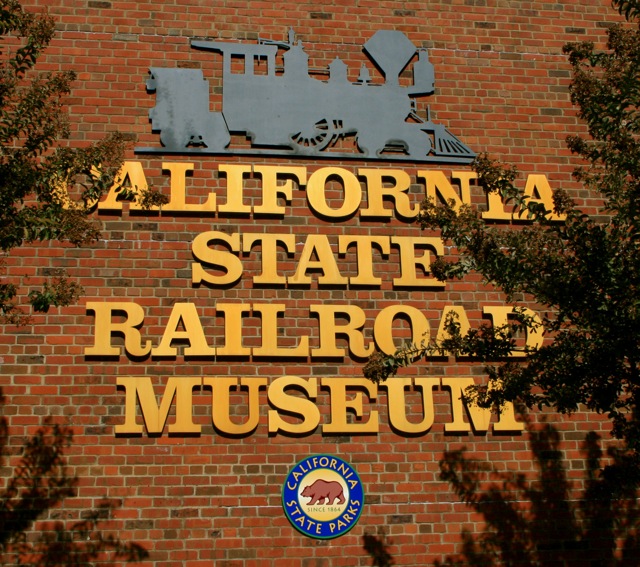
Text and Photos by Carl Morrison,
Carl@TrainWeb.com
David Plowden's Talk about his Railroad Photography, with selected photos
from his other interests: Grain Elevators and Bridges.
Up in time for breakfast at the Vagabond Inn of boiled eggs and fresh
waffles and juice, I had plenty of time to get myself organized to be across
the street (through the parking garage) at the California State Railroad
Museum for David's scheduled 11 a.m. talk.
The show was to be in the East Theatre, and I had about twenty minutes
to take a quick look into the musuem and snap a few photos of my favorite
cab-forward 4294. I spotted David getting ready for his talk and asking
for a chair to use while he made his presentation.
David was born in 1932, and when he moved slowly from his audience seat
to the podium after his introduction, he said, "I'm about ready for the
scrap yard."
His black and white slides, taken with his Hasselblad, were projected
to about 20 feet by 20 feet in the theatre. He talked about each slide
with authority. He described taking the photos, mostly in the upper
regions of the USA and Canada, during the winter when the steam looks the
best.
I do not have any shots of his theatre presentation, but I do have a
link on the Links page that is a slide show with the same photos he presented
in the show.
David began by showing the first photo he'd ever taken, at age 11, in
1943, taken with a Brownie Box Camera, of a steam engine approaching a
station.
He said he had wanted to be a railroader, and accomplished that but
quit when they promoted him to a desk job away from a job where he could
ride daily in a steam locomotive.
He was an assistant to Minor White and Edward Weston. Both used
the zone system. He photographed the Rutland with
Bill Cannon, Conductor, to Bellows Falls. For years he got cab rides
on these 54 miles.
1951 he went to Yale and studied Economics, because he wanted to become
a railroader. In 1955 he got a job in Montana where steam was still
running with 0-8 Makados. He had the run of the railroad and knew
all the engineers and employees. He told them where he was shooting
that day and asked the engineers to sand the flues for good photos. His
boss asked him to photograph out of town because the smoke and soot was
ruining too many lady's laundry in town. When promoted to a desk
job, he started working in travel.
He met O. Winston Link and became his assistant in 1958. Link
worked for the NY Central as a bridge photographer. 1959 David went
to Minor White, got to be an assistant, and got the run of Canadian Pacific
to shoot anything anywhere because his boss knew steam was going out.
All his shots are in winter with steam swirling all around the locomotives.
He said his favorite place was in the roundhouse with the locomotives
steamed up. He said you could really commune with them there, like
giant gentle beasts.
He liked steam locomotivHe had some photos of es because "you can see
how it works" from outside. Not like the couling added later and
on diesels. That's like cows behind a fence. "You can see a
diesel locomotive or an airplane, but you don't know how it works!"
He had some photos of railroad bridges. Railroads have abandoned
the rights-of-way but left the bridges. He said some photos were of
viaducts and others were of bridges. Later I asked him the difference
and he said a viaduct crosses a ravine or valley or non-navigable water,
where a bridge crosses navagable water. Some bridges he showed were
truss bridges.
He had a photo of the Superior, WI, ore docks, where I have been, and
he mentioned that it is a mile long, one of the largest manmade structures
in the world, and can be see from an airplane at 36,000 feet.
With many of his photos he used the term, "Whistle Off", to mean the
train starting up from the station.
He also used "Train Time" in a small town for the time for the train
to arrive. He said "Train Time" is when the world stops at your town's
station.
He called himself an "Iternate Photographer." He also referred
to "Steam Town" in Scranton, PA.
(Click any photo below for a double-sized copy;
Click BACK in your browser to return to this page.)
The featured, cab-forward 4294 locomotive int he
museum to which David referred many times during his talk.
|
David Plowden, at his computer during the show and
note reading about each slide.
|
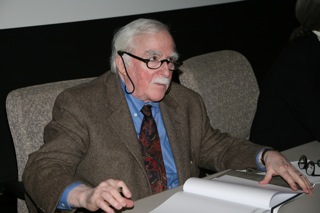
David Plowden, in another pair of glasses, for signing
purchased copies of "Requiem for Steam."
|
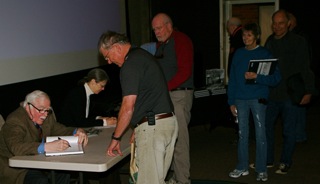
This was not as large a crowd to purchase his book as the evening Trainmaster's
Reception. |
David talked and showed slides for 1 1/2 hours, and every
minute was intriguing. Afterwards, I walked through the museum again,
to view his exhibition and trying for more photos. From the Jacket
of his book:
After a quick look online, I found the book for about
$40 at: http://www.amazon.com/Requiem-Steam-Railroad-Photographs-Plowden/dp/0393079082
FROM THE JACKET: As a child, David Plowden was given an
inexpensive box camera and before long he began to photograph railroad trains.
As he matured and started on what would become a lifetime in photography,
trains — specifically steam locomotives — continued to be one of his passions.
But by the beginning of the 1960s they were eclipsed by diesel engines;
the steam era had ended.
It is our good fortune that Plowden was passionate about trains. For
years he photographed not only the locomotives but all facets of the railroad
world, from long steam-powered freight trains crisscrossing middle America
to the yards, small stations, and industrial settings that are synonymous
with trains. While his photographic love affair with America, and in particular
the mid-West where he lives, resulted in many books and exhibitions of his
beautiful docu- mentary photographs, he never lost sight of the railroads,
where his work would result in the images presented in this book, a reverent
tribute and requiem for the era of steam.
David Plowden is the author of more than twenty photography books, including
Vanishing Point: Fifty Years of Photography, published by Norton. As a young
man out of college he worked on the Great Northern Railroad in Minnesota,
and when the opportunity presented itself, he photographed trains. Later,
as he became increasingly well known in the world of photography, he continued
to document the railroad world but it was not the same. The exhilaration
of a steam locomotive thundering down the track was gone. It lives on in
this book.
|
|
|
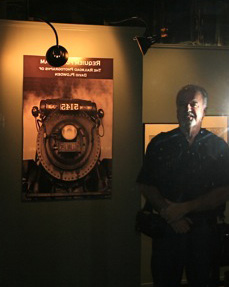
Just playin' around.
|
|
Enjoyed David Plowden's talk at the California State Railroad
Museum. He's also speaking in Chicago about his recent book, "Requiem
for Steam", Details: http://www.davidplowden.com/?p=546
Slide show of his black and white photos used in the talk and book:
http://www.davidplowden.com/?cat=16
He also had railroad bridge photos from his Bridges book mixed into
his talk: http://www.davidplowden.com/?cat=11
Other categories of his photos: * Bridges
* Industry * Marine * Requiem for Steam
* Rural America * Small Towns * Wasteland
all his photos are black and white. Click any of these categories of
photos from the home page: http://www.davidplowden.com/
Born 10 years before me, I can relate to all the photos he took in all
categories. If you think his photos are great, and you are a railroad
photographer, you must hear him talk about his photos in person,
it's "Goosebump Time."
Other photos in the Museum
They had signs and banners left over from an earlier
exhibition titled, "Rails and Reels" about movies made about trains. I
purchased a copy of "Silver Streak" in the gift shop.
|
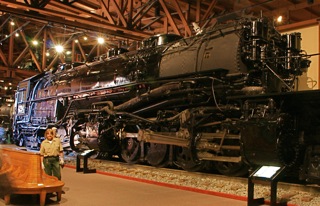
No. 4294

|
|
|
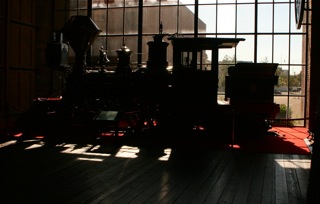
I like the silhouette of this ancient locomotive
by the window of the museum.
|
I don't remember seeing Northwestern Pacific 4-6-0 No. 112
here at the museum before, so I did quite a photo study of it. It's
a good thing that I did because the No. 112 and the No. 613 were pulled
out of the roundhouse for the reception.
|
|
|
No. 112

|
|

No. 13 Empire surrounded by glass.
|
|
|
|
|
Roundhouse and turntable.
|
Small Locomotive in Lobby.
|
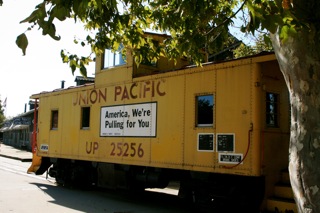
Union Pacific Caboose in outside display.
|
Double-deck rotating bridge beside the Museum
|
Next Page:
The Trainmaster's Reception.
[
Beginning of this Travelogue |
Top of This Page |
Other
Reports by Carl Morrison |
TrainWeb.com
|
SilverRails.com ]

